Calculus TMA3 Solutions: Analytical Methods for Engineers
VerifiedAdded on 2023/06/11
|11
|1417
|131
Homework Assignment
AI Summary
This document provides detailed solutions to an Engineering Mathematics assignment focusing on Calculus, specifically TMA3 from the Analytical Methods for Engineers module. The solutions cover a range of calculus topics, including differentiation (product rule, chain rule), applications of differentiation (angular velocity and acceleration), optimization problems (maximizing volume), and integration (indefinite and definite integrals). The document also addresses applications of integration, such as finding the area under a curve and solving population growth problems. Each question is addressed with step-by-step explanations, making it a valuable resource for students studying engineering mathematics. Desklib offers a wealth of similar solved assignments and past papers to aid student learning.
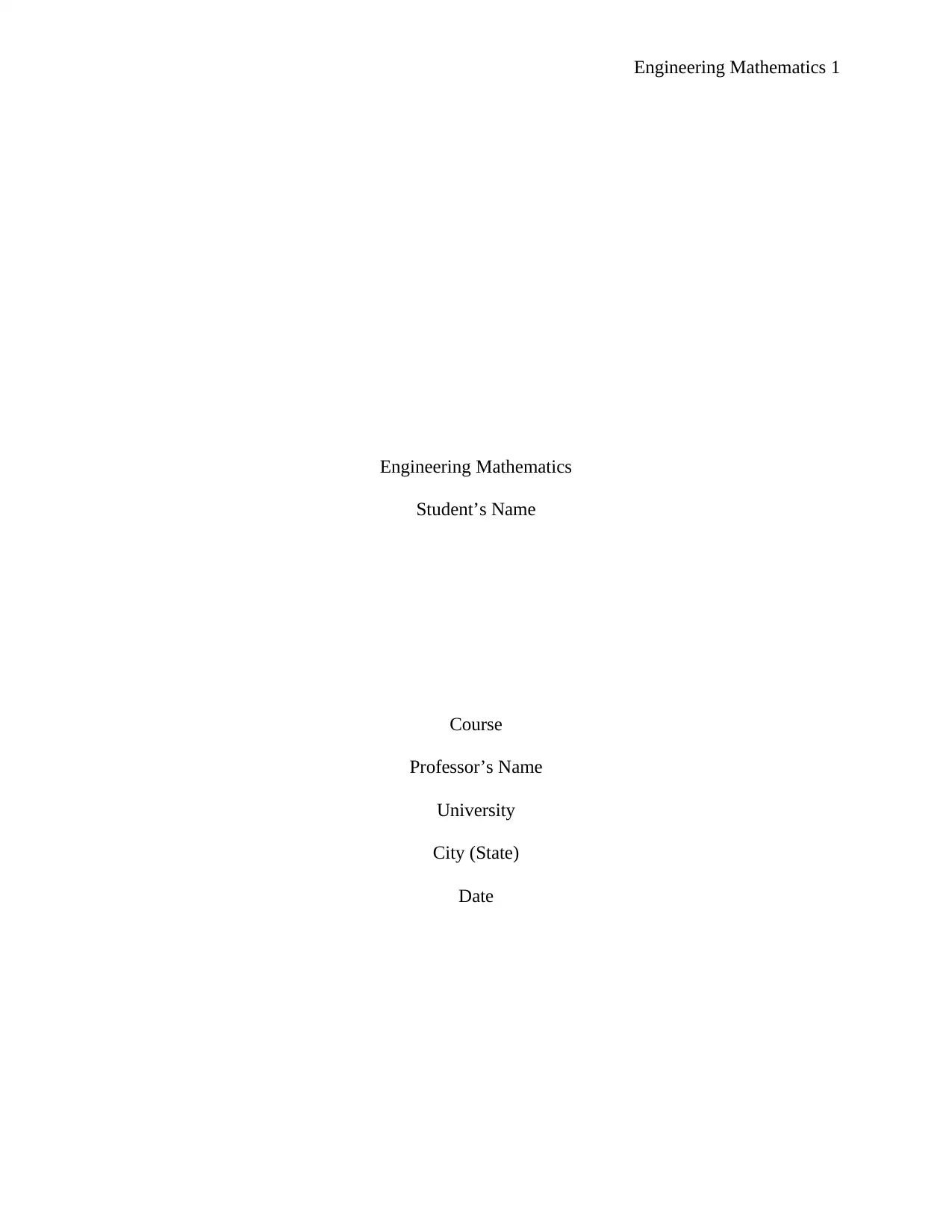
Engineering Mathematics 1
Engineering Mathematics
Student’s Name
Course
Professor’s Name
University
City (State)
Date
Engineering Mathematics
Student’s Name
Course
Professor’s Name
University
City (State)
Date
Paraphrase This Document
Need a fresh take? Get an instant paraphrase of this document with our AI Paraphraser
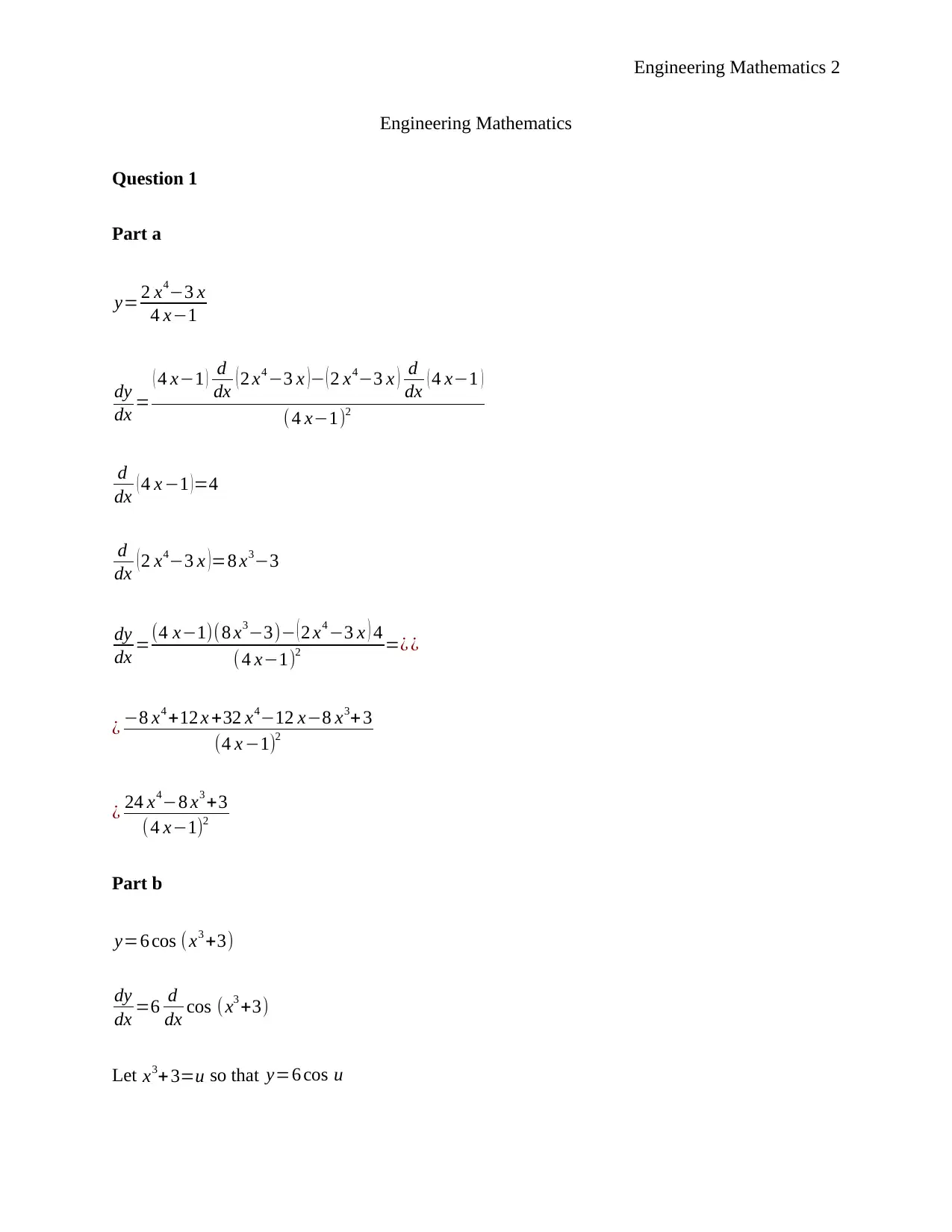
Engineering Mathematics 2
Engineering Mathematics
Question 1
Part a
y= 2 x4−3 x
4 x−1
dy
dx =
( 4 x−1 ) d
dx ( 2 x4 −3 x )− ( 2 x4−3 x ) d
dx ( 4 x−1 )
( 4 x−1)2
d
dx ( 4 x −1 )=4
d
dx (2 x4−3 x )=8 x3−3
dy
dx =(4 x−1)(8 x3−3)− ( 2 x4 −3 x ) 4
( 4 x−1)2 =¿ ¿
¿ −8 x4 +12 x +32 x4−12 x−8 x3+3
(4 x −1)2
¿ 24 x4−8 x3 +3
(4 x−1)2
Part b
y=6 cos ( x3 +3)
dy
dx =6 d
dx cos ( x3 +3)
Let x3+3=u so that y=6 cos u
Engineering Mathematics
Question 1
Part a
y= 2 x4−3 x
4 x−1
dy
dx =
( 4 x−1 ) d
dx ( 2 x4 −3 x )− ( 2 x4−3 x ) d
dx ( 4 x−1 )
( 4 x−1)2
d
dx ( 4 x −1 )=4
d
dx (2 x4−3 x )=8 x3−3
dy
dx =(4 x−1)(8 x3−3)− ( 2 x4 −3 x ) 4
( 4 x−1)2 =¿ ¿
¿ −8 x4 +12 x +32 x4−12 x−8 x3+3
(4 x −1)2
¿ 24 x4−8 x3 +3
(4 x−1)2
Part b
y=6 cos ( x3 +3)
dy
dx =6 d
dx cos ( x3 +3)
Let x3+3=u so that y=6 cos u
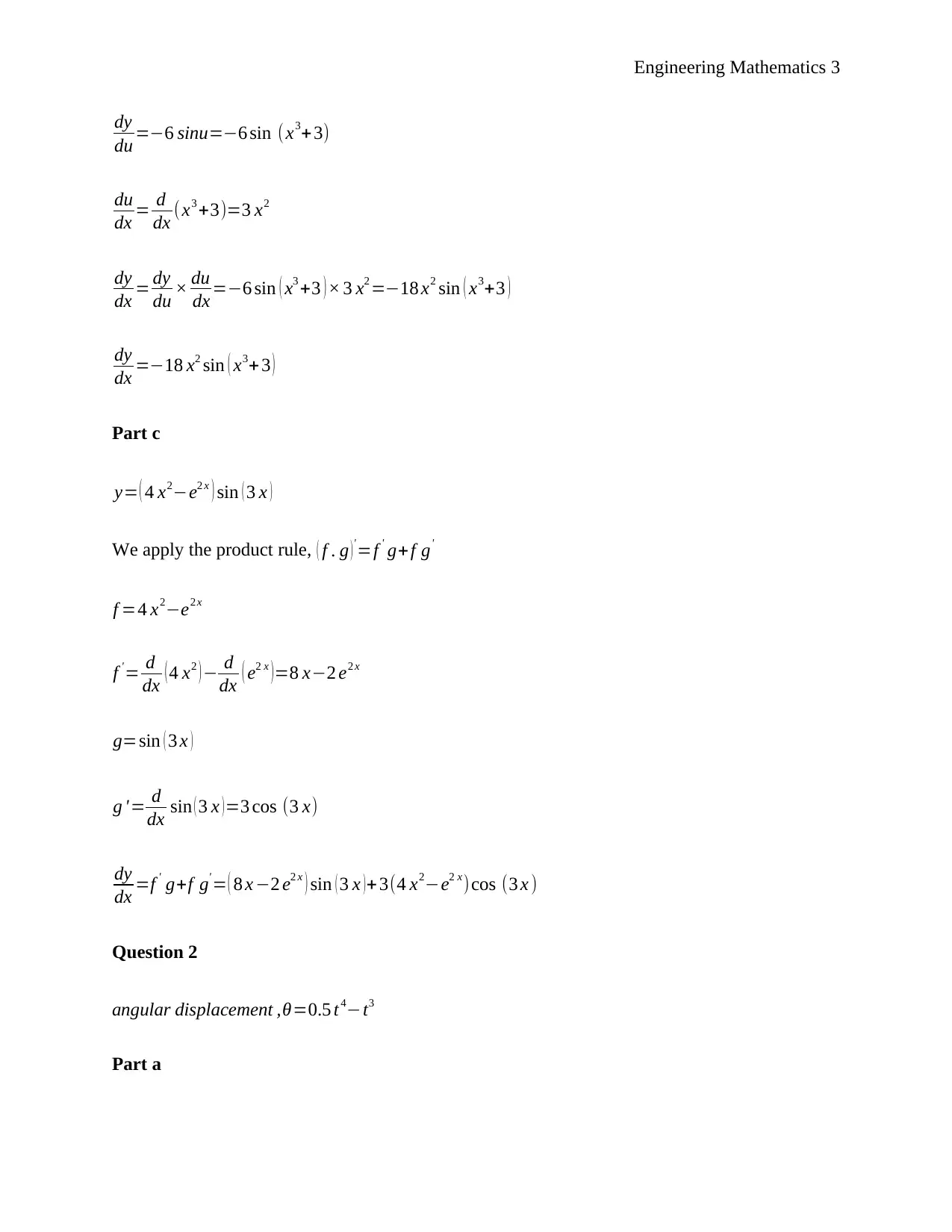
Engineering Mathematics 3
dy
du =−6 sinu=−6 sin (x3+ 3)
du
dx = d
dx (x3 +3)=3 x2
dy
dx = dy
du × du
dx =−6 sin ( x3 +3 ) × 3 x2 =−18 x2 sin ( x3+3 )
dy
dx =−18 x2 sin ( x3+ 3 )
Part c
y= ( 4 x2−e2 x ) sin ( 3 x )
We apply the product rule, ( f . g ) '=f ' g+ f g'
f =4 x2−e2 x
f '= d
dx ( 4 x2 ) − d
dx ( e2 x ) =8 x−2 e2 x
g=sin ( 3 x )
g '= d
dx sin ( 3 x ) =3 cos (3 x)
dy
dx =f ' g+f g' = ( 8 x −2 e2 x ) sin ( 3 x )+ 3(4 x2−e2 x)cos (3 x )
Question 2
angular displacement ,θ=0.5 t4−t3
Part a
dy
du =−6 sinu=−6 sin (x3+ 3)
du
dx = d
dx (x3 +3)=3 x2
dy
dx = dy
du × du
dx =−6 sin ( x3 +3 ) × 3 x2 =−18 x2 sin ( x3+3 )
dy
dx =−18 x2 sin ( x3+ 3 )
Part c
y= ( 4 x2−e2 x ) sin ( 3 x )
We apply the product rule, ( f . g ) '=f ' g+ f g'
f =4 x2−e2 x
f '= d
dx ( 4 x2 ) − d
dx ( e2 x ) =8 x−2 e2 x
g=sin ( 3 x )
g '= d
dx sin ( 3 x ) =3 cos (3 x)
dy
dx =f ' g+f g' = ( 8 x −2 e2 x ) sin ( 3 x )+ 3(4 x2−e2 x)cos (3 x )
Question 2
angular displacement ,θ=0.5 t4−t3
Part a
⊘ This is a preview!⊘
Do you want full access?
Subscribe today to unlock all pages.

Trusted by 1+ million students worldwide
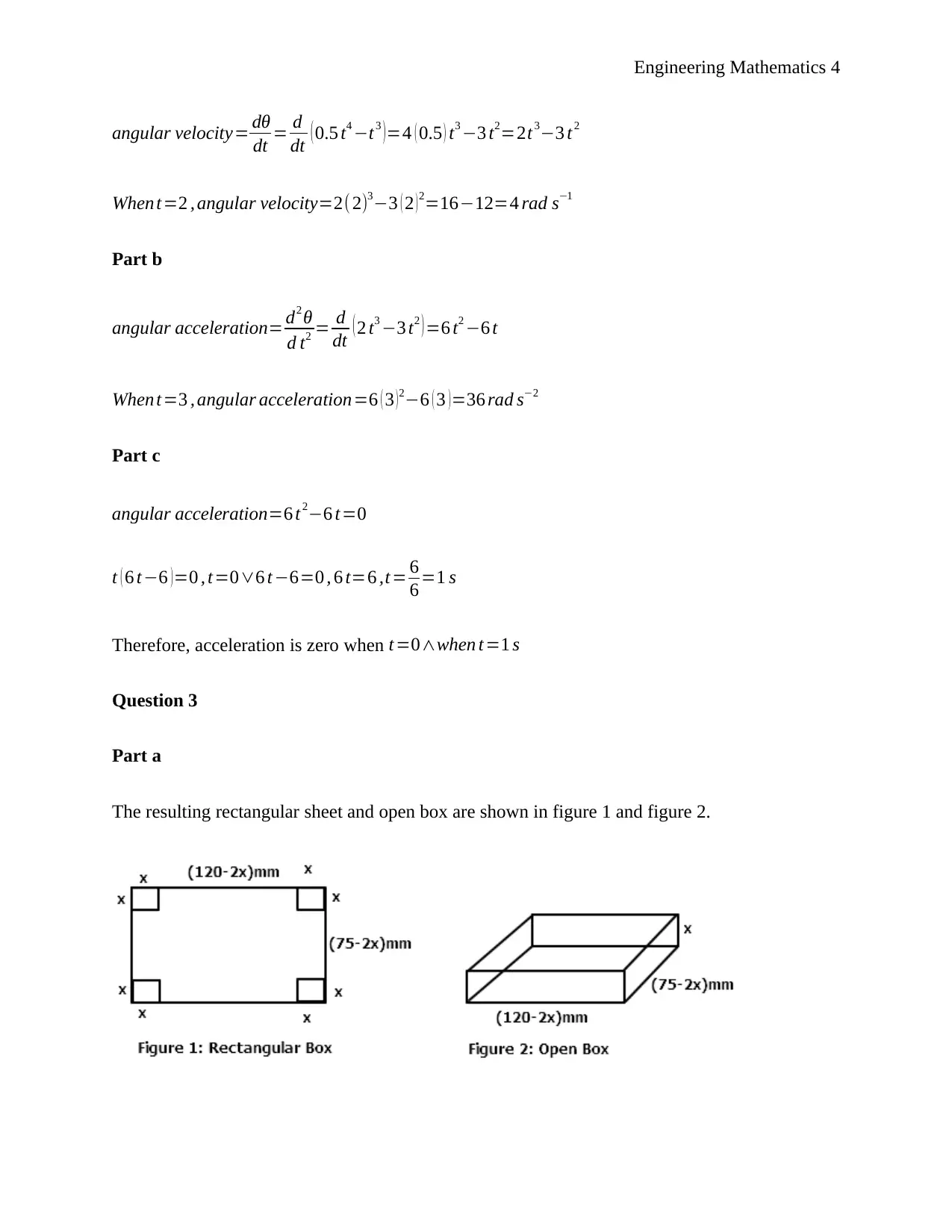
Engineering Mathematics 4
angular velocity= dθ
dt = d
dt ( 0.5 t4 −t3 )=4 ( 0.5 ) t3 −3 t2=2t3−3 t2
When t=2 , angular velocity=2( 2)3−3 ( 2 )2=16−12=4 rad s−1
Part b
angular acceleration= d2 θ
d t2 = d
dt ( 2 t3 −3 t2 ) =6 t2 −6 t
When t=3 , angular acceleration=6 ( 3 ) 2−6 ( 3 ) =36 rad s−2
Part c
angular acceleration=6 t2−6 t=0
t ( 6 t−6 )=0 , t=0∨6 t−6=0 , 6 t=6 ,t= 6
6 =1 s
Therefore, acceleration is zero when t=0∧when t =1 s
Question 3
Part a
The resulting rectangular sheet and open box are shown in figure 1 and figure 2.
angular velocity= dθ
dt = d
dt ( 0.5 t4 −t3 )=4 ( 0.5 ) t3 −3 t2=2t3−3 t2
When t=2 , angular velocity=2( 2)3−3 ( 2 )2=16−12=4 rad s−1
Part b
angular acceleration= d2 θ
d t2 = d
dt ( 2 t3 −3 t2 ) =6 t2 −6 t
When t=3 , angular acceleration=6 ( 3 ) 2−6 ( 3 ) =36 rad s−2
Part c
angular acceleration=6 t2−6 t=0
t ( 6 t−6 )=0 , t=0∨6 t−6=0 , 6 t=6 ,t= 6
6 =1 s
Therefore, acceleration is zero when t=0∧when t =1 s
Question 3
Part a
The resulting rectangular sheet and open box are shown in figure 1 and figure 2.
Paraphrase This Document
Need a fresh take? Get an instant paraphrase of this document with our AI Paraphraser
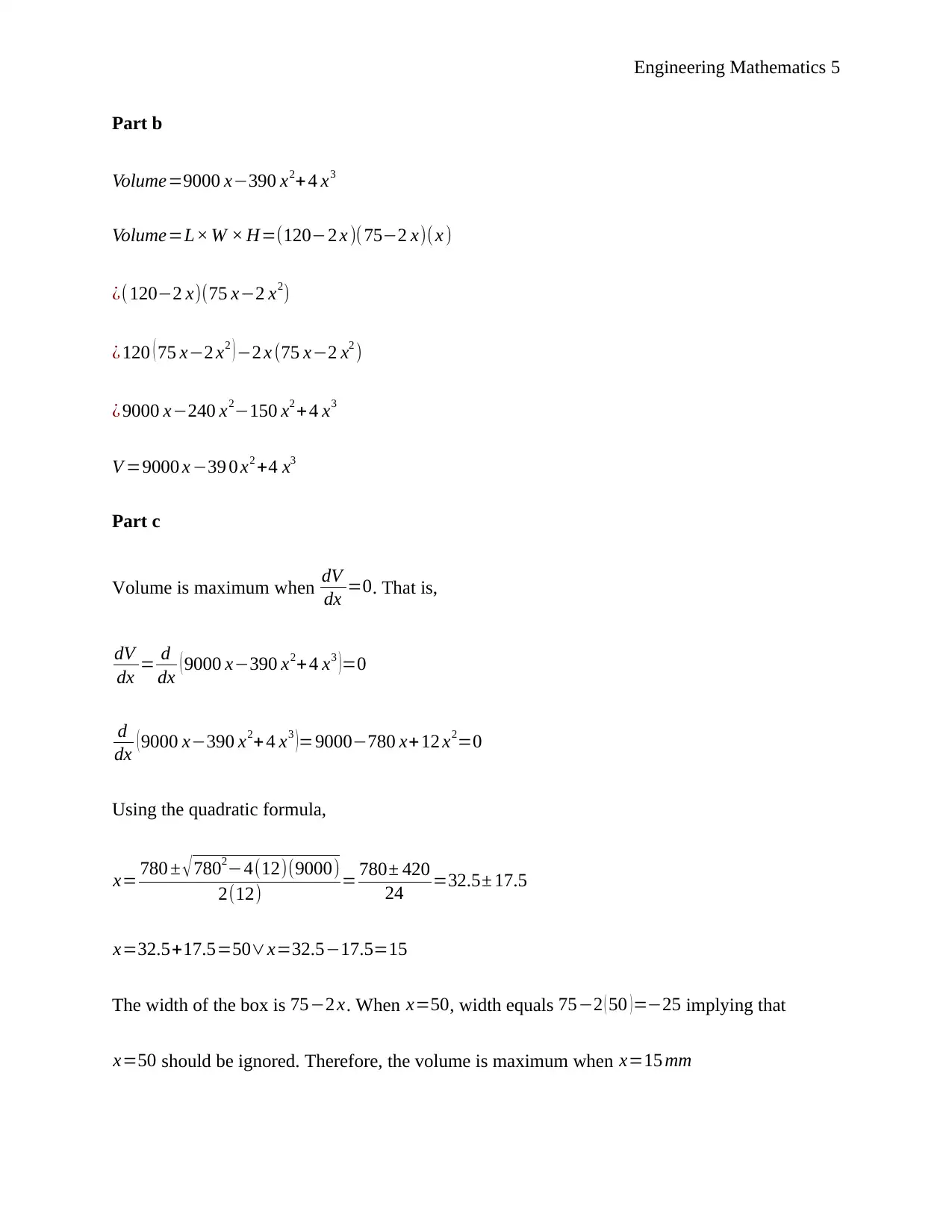
Engineering Mathematics 5
Part b
Volume=9000 x−390 x2+4 x3
Volume=L× W × H=(120−2 x )(75−2 x)( x )
¿( 120−2 x)(75 x−2 x2)
¿ 120 ( 75 x−2 x2 ) −2 x (75 x−2 x2 )
¿ 9000 x−240 x2−150 x2 + 4 x3
V =9000 x −39 0 x2 +4 x3
Part c
Volume is maximum when dV
dx =0. That is,
dV
dx = d
dx ( 9000 x−390 x2+ 4 x3 )=0
d
dx ( 9000 x−390 x2+ 4 x3 )=9000−780 x+12 x2=0
Using the quadratic formula,
x= 780 ± √7802−4(12)(9000)
2(12) = 780± 420
24 =32.5± 17.5
x=32.5+17.5=50∨x=32.5−17.5=15
The width of the box is 75−2 x. When x=50, width equals 75−2 ( 50 )=−25 implying that
x=50 should be ignored. Therefore, the volume is maximum when x=15 mm
Part b
Volume=9000 x−390 x2+4 x3
Volume=L× W × H=(120−2 x )(75−2 x)( x )
¿( 120−2 x)(75 x−2 x2)
¿ 120 ( 75 x−2 x2 ) −2 x (75 x−2 x2 )
¿ 9000 x−240 x2−150 x2 + 4 x3
V =9000 x −39 0 x2 +4 x3
Part c
Volume is maximum when dV
dx =0. That is,
dV
dx = d
dx ( 9000 x−390 x2+ 4 x3 )=0
d
dx ( 9000 x−390 x2+ 4 x3 )=9000−780 x+12 x2=0
Using the quadratic formula,
x= 780 ± √7802−4(12)(9000)
2(12) = 780± 420
24 =32.5± 17.5
x=32.5+17.5=50∨x=32.5−17.5=15
The width of the box is 75−2 x. When x=50, width equals 75−2 ( 50 )=−25 implying that
x=50 should be ignored. Therefore, the volume is maximum when x=15 mm
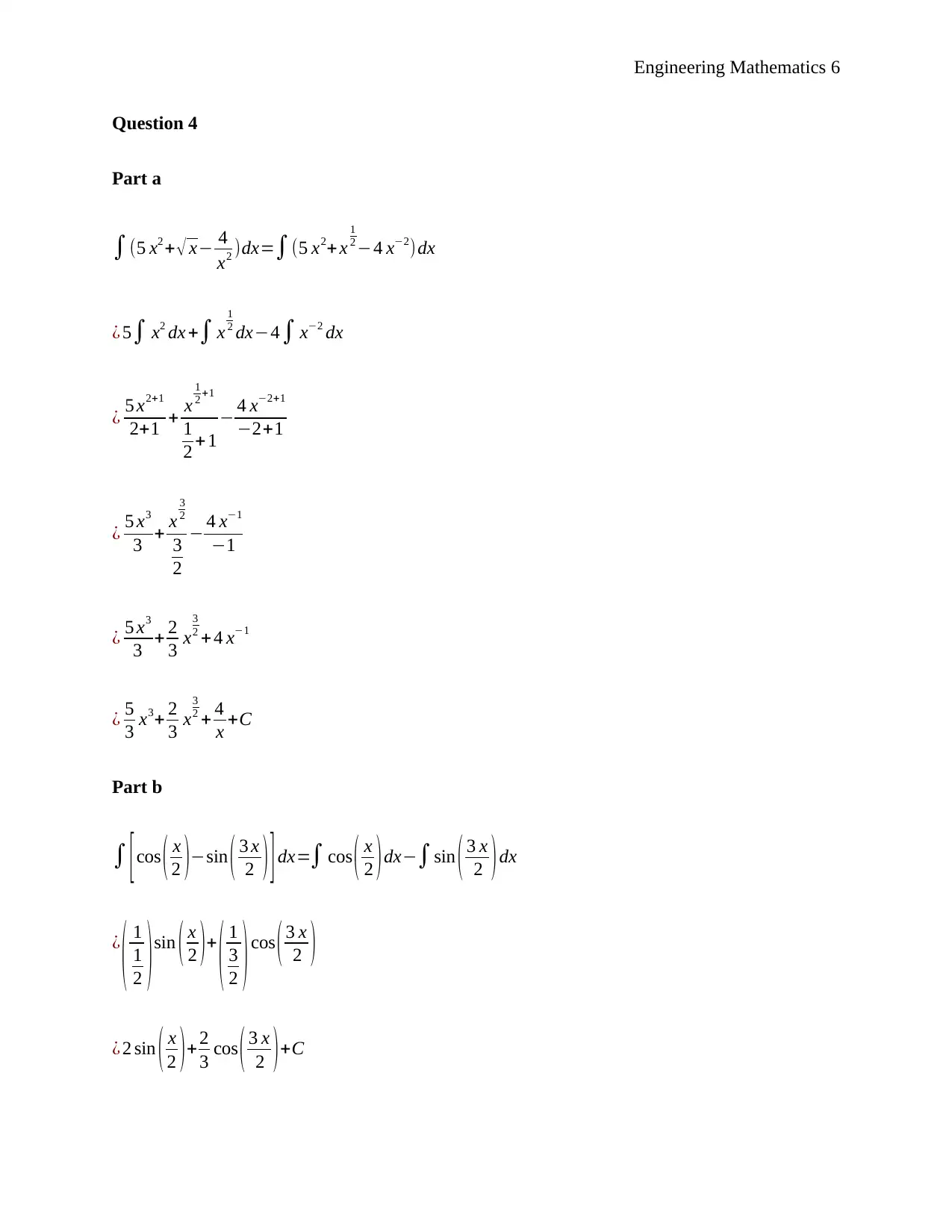
Engineering Mathematics 6
Question 4
Part a
∫(5 x2 + √ x− 4
x2 )dx=∫(5 x2+ x
1
2 −4 x−2)dx
¿ 5∫ x2 dx +∫ x
1
2 dx−4∫ x−2 dx
¿ 5 x2+1
2+1 + x
1
2 +1
1
2 + 1
− 4 x−2+1
−2+1
¿ 5 x3
3 + x
3
2
3
2
− 4 x−1
−1
¿ 5 x3
3 + 2
3 x
3
2 + 4 x−1
¿ 5
3 x3+ 2
3 x
3
2 + 4
x +C
Part b
∫ [cos ( x
2 )−sin ( 3 x
2 ) ] dx=∫ cos ( x
2 )dx−∫sin ( 3 x
2 )dx
¿
( 1
1
2 ) sin ( x
2 ) +
( 1
3
2 ) cos ( 3 x
2 )
¿ 2 sin ( x
2 )+ 2
3 cos ( 3 x
2 )+C
Question 4
Part a
∫(5 x2 + √ x− 4
x2 )dx=∫(5 x2+ x
1
2 −4 x−2)dx
¿ 5∫ x2 dx +∫ x
1
2 dx−4∫ x−2 dx
¿ 5 x2+1
2+1 + x
1
2 +1
1
2 + 1
− 4 x−2+1
−2+1
¿ 5 x3
3 + x
3
2
3
2
− 4 x−1
−1
¿ 5 x3
3 + 2
3 x
3
2 + 4 x−1
¿ 5
3 x3+ 2
3 x
3
2 + 4
x +C
Part b
∫ [cos ( x
2 )−sin ( 3 x
2 ) ] dx=∫ cos ( x
2 )dx−∫sin ( 3 x
2 )dx
¿
( 1
1
2 ) sin ( x
2 ) +
( 1
3
2 ) cos ( 3 x
2 )
¿ 2 sin ( x
2 )+ 2
3 cos ( 3 x
2 )+C
⊘ This is a preview!⊘
Do you want full access?
Subscribe today to unlock all pages.

Trusted by 1+ million students worldwide
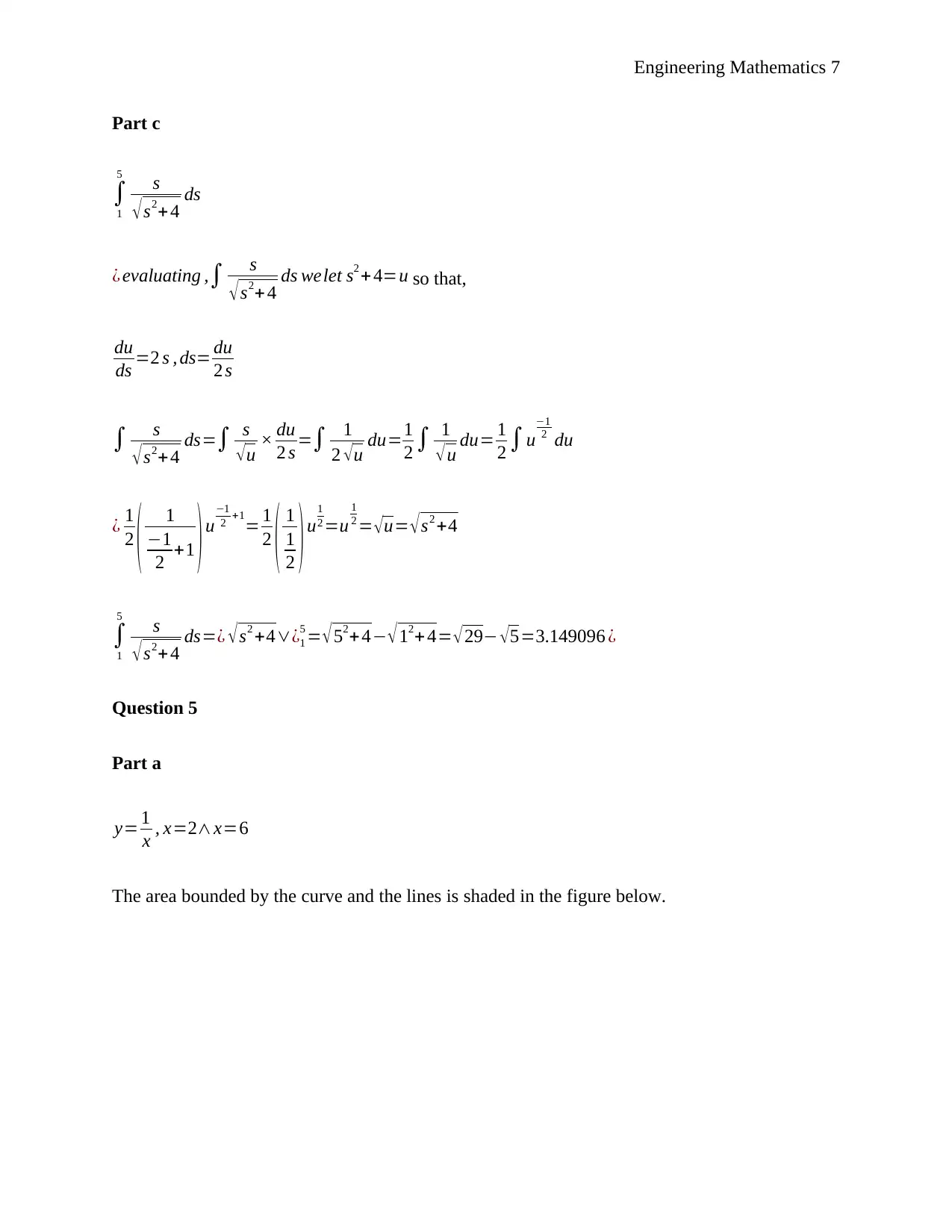
Engineering Mathematics 7
Part c
∫
1
5
s
√ s2+4 ds
¿ evaluating ,∫ s
√s2+ 4 ds welet s2 + 4=u so that,
du
ds =2 s , ds= du
2 s
∫ s
√ s2+ 4 ds=∫ s
√ u × du
2 s =∫ 1
2 √ u du=1
2 ∫ 1
√ u du= 1
2 ∫u
−1
2 du
¿ 1
2 ( 1
−1
2 +1 )u
−1
2 +1
= 1
2 ( 1
1
2 )u
1
2 =u
1
2 = √u= √s2 +4
∫
1
5
s
√ s2+4 ds=¿ √ s2 +4∨¿1
5 = √ 52+ 4− √ 12+ 4= √ 29− √ 5=3.149096 ¿
Question 5
Part a
y= 1
x , x=2∧x=6
The area bounded by the curve and the lines is shaded in the figure below.
Part c
∫
1
5
s
√ s2+4 ds
¿ evaluating ,∫ s
√s2+ 4 ds welet s2 + 4=u so that,
du
ds =2 s , ds= du
2 s
∫ s
√ s2+ 4 ds=∫ s
√ u × du
2 s =∫ 1
2 √ u du=1
2 ∫ 1
√ u du= 1
2 ∫u
−1
2 du
¿ 1
2 ( 1
−1
2 +1 )u
−1
2 +1
= 1
2 ( 1
1
2 )u
1
2 =u
1
2 = √u= √s2 +4
∫
1
5
s
√ s2+4 ds=¿ √ s2 +4∨¿1
5 = √ 52+ 4− √ 12+ 4= √ 29− √ 5=3.149096 ¿
Question 5
Part a
y= 1
x , x=2∧x=6
The area bounded by the curve and the lines is shaded in the figure below.
Paraphrase This Document
Need a fresh take? Get an instant paraphrase of this document with our AI Paraphraser
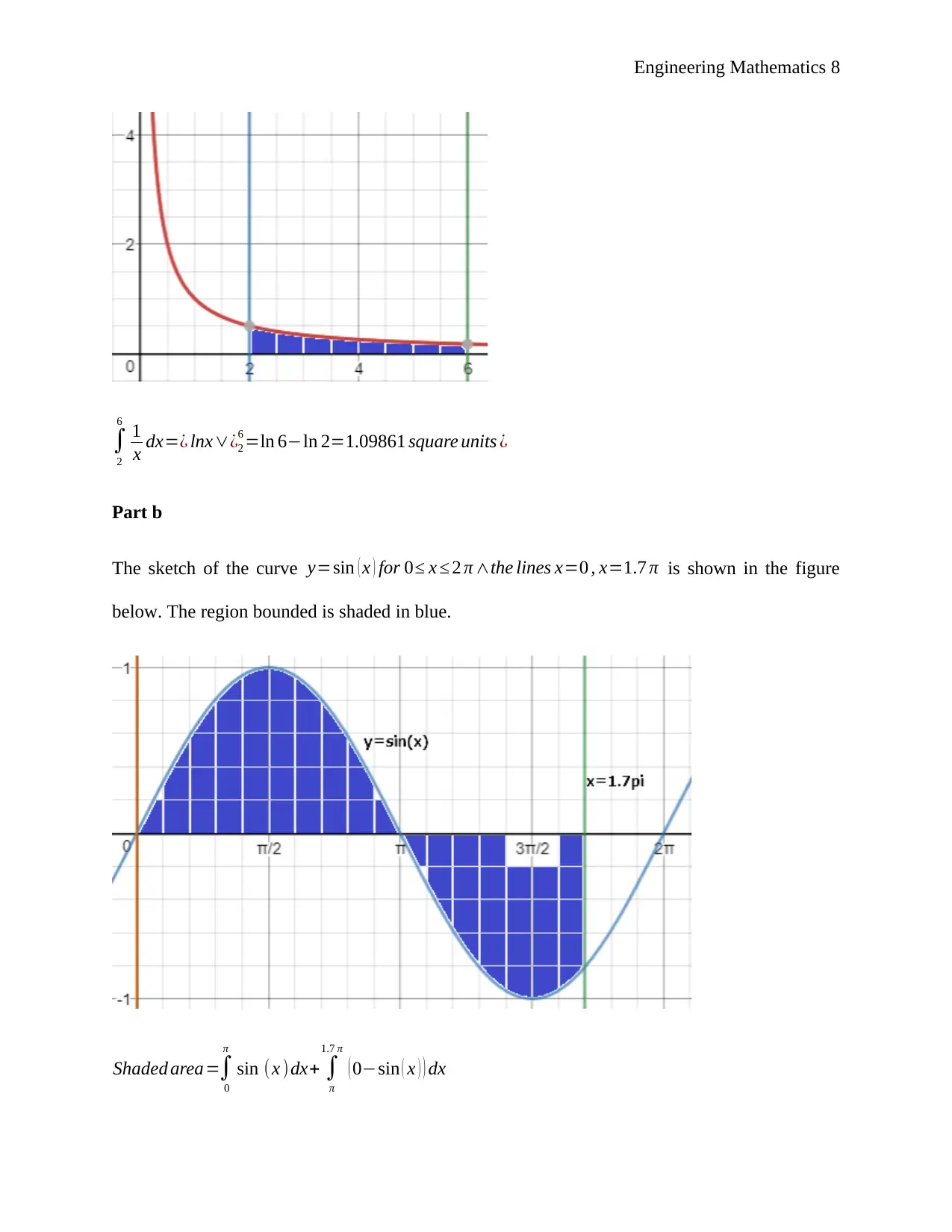
Engineering Mathematics 8
∫
2
6
1
x dx=¿ lnx∨¿2
6 =ln 6−ln 2=1.09861 square units ¿
Part b
The sketch of the curve y=sin ( x ) for 0≤ x ≤ 2 π ∧the lines x=0 , x=1.7 π is shown in the figure
below. The region bounded is shaded in blue.
Shaded area=∫
0
π
sin (x )dx+ ∫
π
1.7 π
( 0−sin ( x ) ) dx
∫
2
6
1
x dx=¿ lnx∨¿2
6 =ln 6−ln 2=1.09861 square units ¿
Part b
The sketch of the curve y=sin ( x ) for 0≤ x ≤ 2 π ∧the lines x=0 , x=1.7 π is shown in the figure
below. The region bounded is shaded in blue.
Shaded area=∫
0
π
sin (x )dx+ ∫
π
1.7 π
( 0−sin ( x ) ) dx
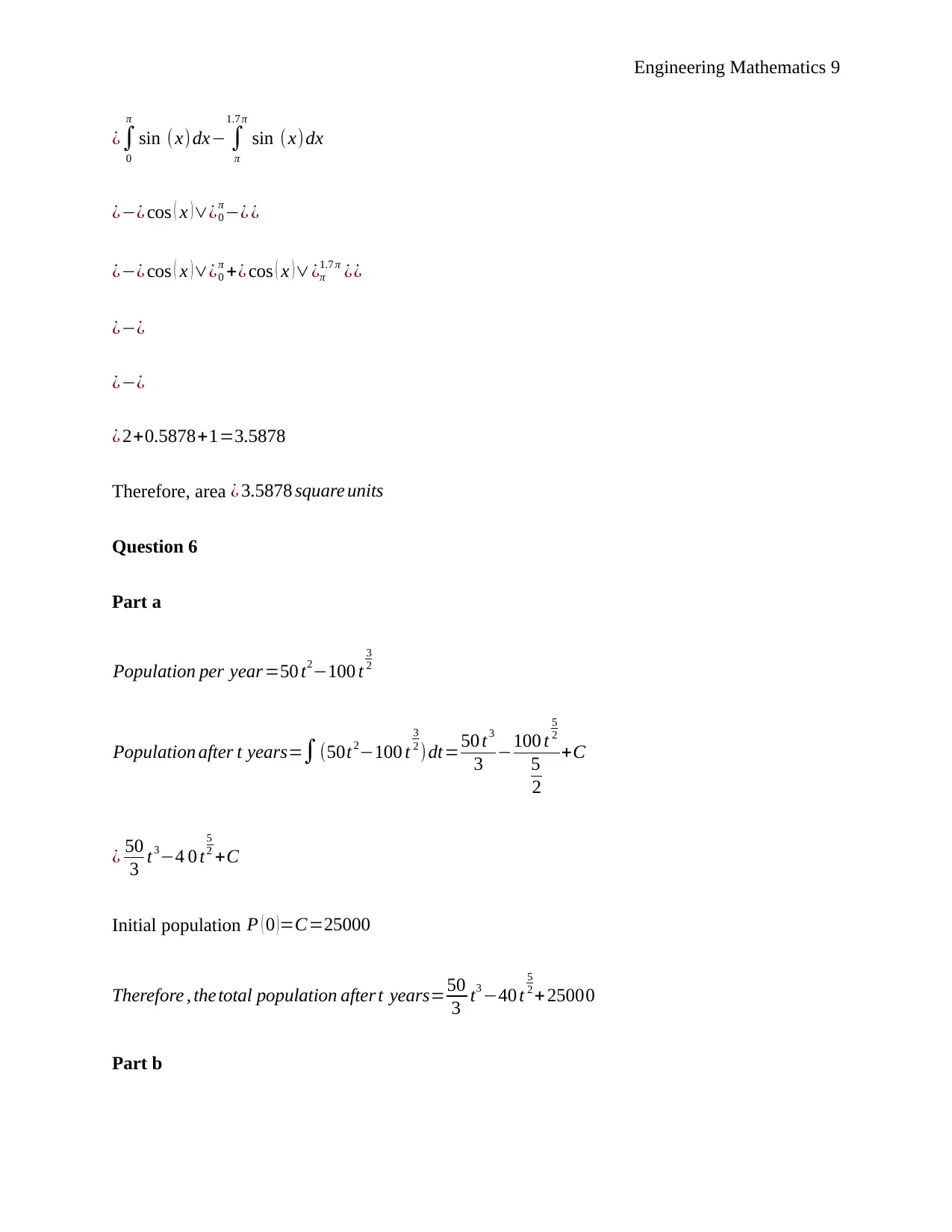
Engineering Mathematics 9
¿∫
0
π
sin (x) dx− ∫
π
1.7 π
sin (x)dx
¿−¿ cos ( x )∨¿0
π −¿ ¿
¿−¿ cos ( x )∨¿0
π +¿ cos ( x )∨¿π
1.7 π ¿¿
¿−¿
¿−¿
¿ 2+0.5878+1=3.5878
Therefore, area ¿ 3.5878 square units
Question 6
Part a
Population per year=50 t2−100 t
3
2
Population after t years=∫(50t2−100 t
3
2 )dt=50 t3
3 −100 t
5
2
5
2
+C
¿ 50
3 t3−4 0 t
5
2 +C
Initial population P ( 0 )=C=25000
Therefore , thetotal population after t years=50
3 t3 −40 t
5
2 + 25000
Part b
¿∫
0
π
sin (x) dx− ∫
π
1.7 π
sin (x)dx
¿−¿ cos ( x )∨¿0
π −¿ ¿
¿−¿ cos ( x )∨¿0
π +¿ cos ( x )∨¿π
1.7 π ¿¿
¿−¿
¿−¿
¿ 2+0.5878+1=3.5878
Therefore, area ¿ 3.5878 square units
Question 6
Part a
Population per year=50 t2−100 t
3
2
Population after t years=∫(50t2−100 t
3
2 )dt=50 t3
3 −100 t
5
2
5
2
+C
¿ 50
3 t3−4 0 t
5
2 +C
Initial population P ( 0 )=C=25000
Therefore , thetotal population after t years=50
3 t3 −40 t
5
2 + 25000
Part b
⊘ This is a preview!⊘
Do you want full access?
Subscribe today to unlock all pages.

Trusted by 1+ million students worldwide
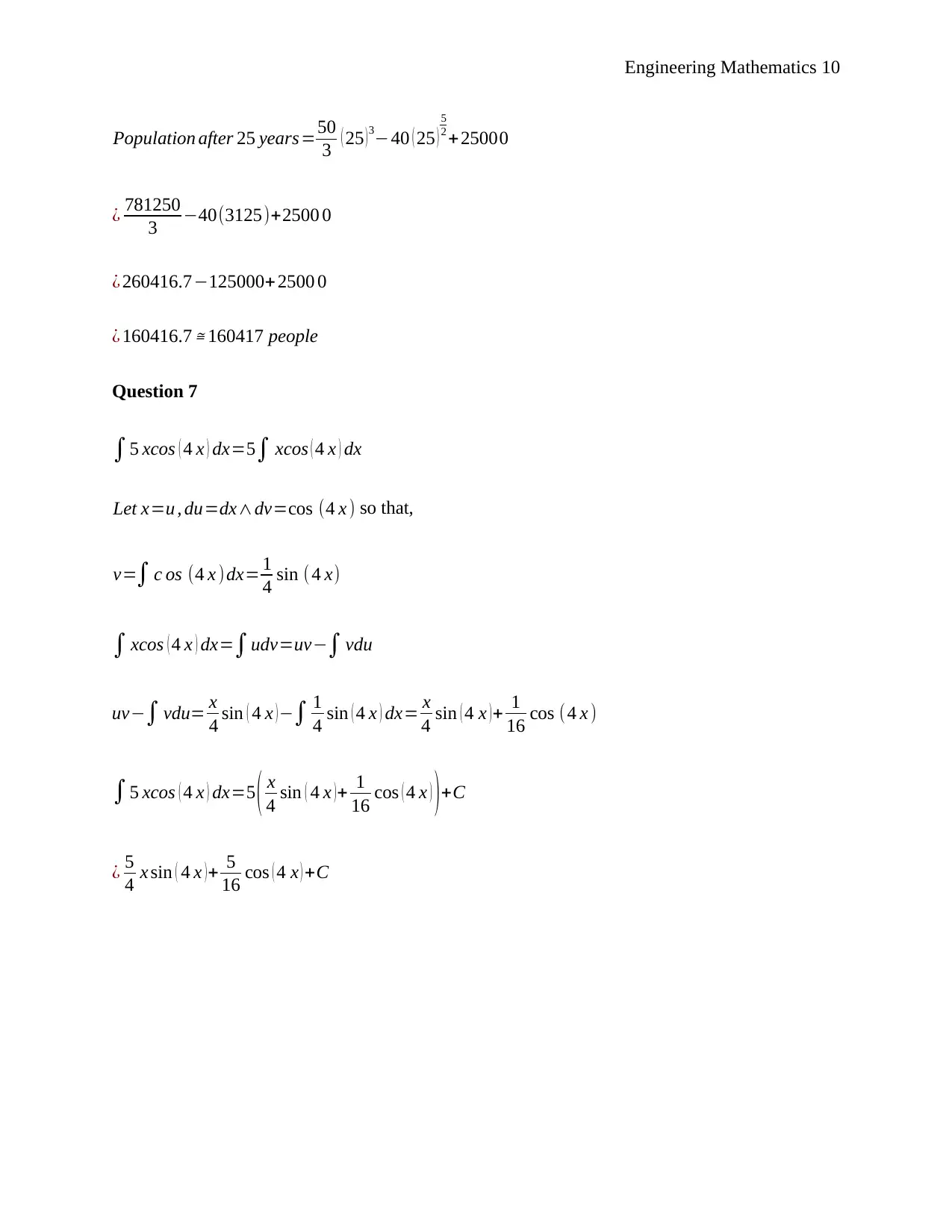
Engineering Mathematics 10
Population after 25 years=50
3 ( 25 )3−40 ( 25 )
5
2 +25000
¿ 781250
3 −40(3125)+2500 0
¿ 260416.7−125000+ 2500 0
¿ 160416.7 ≅ 160417 people
Question 7
∫5 xcos ( 4 x ) dx=5∫ xcos ( 4 x ) dx
Let x=u , du=dx∧dv=cos (4 x ) so that,
v=∫ c os (4 x )dx= 1
4 sin (4 x)
∫ xcos ( 4 x ) dx=∫udv=uv−∫ vdu
uv−∫ vdu= x
4 sin ( 4 x ) −∫ 1
4 sin ( 4 x ) dx= x
4 sin ( 4 x ) + 1
16 cos (4 x )
∫5 xcos ( 4 x ) dx=5 ( x
4 sin ( 4 x )+ 1
16 cos ( 4 x ) )+C
¿ 5
4 x sin ( 4 x ) + 5
16 cos ( 4 x ) +C
Population after 25 years=50
3 ( 25 )3−40 ( 25 )
5
2 +25000
¿ 781250
3 −40(3125)+2500 0
¿ 260416.7−125000+ 2500 0
¿ 160416.7 ≅ 160417 people
Question 7
∫5 xcos ( 4 x ) dx=5∫ xcos ( 4 x ) dx
Let x=u , du=dx∧dv=cos (4 x ) so that,
v=∫ c os (4 x )dx= 1
4 sin (4 x)
∫ xcos ( 4 x ) dx=∫udv=uv−∫ vdu
uv−∫ vdu= x
4 sin ( 4 x ) −∫ 1
4 sin ( 4 x ) dx= x
4 sin ( 4 x ) + 1
16 cos (4 x )
∫5 xcos ( 4 x ) dx=5 ( x
4 sin ( 4 x )+ 1
16 cos ( 4 x ) )+C
¿ 5
4 x sin ( 4 x ) + 5
16 cos ( 4 x ) +C
Paraphrase This Document
Need a fresh take? Get an instant paraphrase of this document with our AI Paraphraser
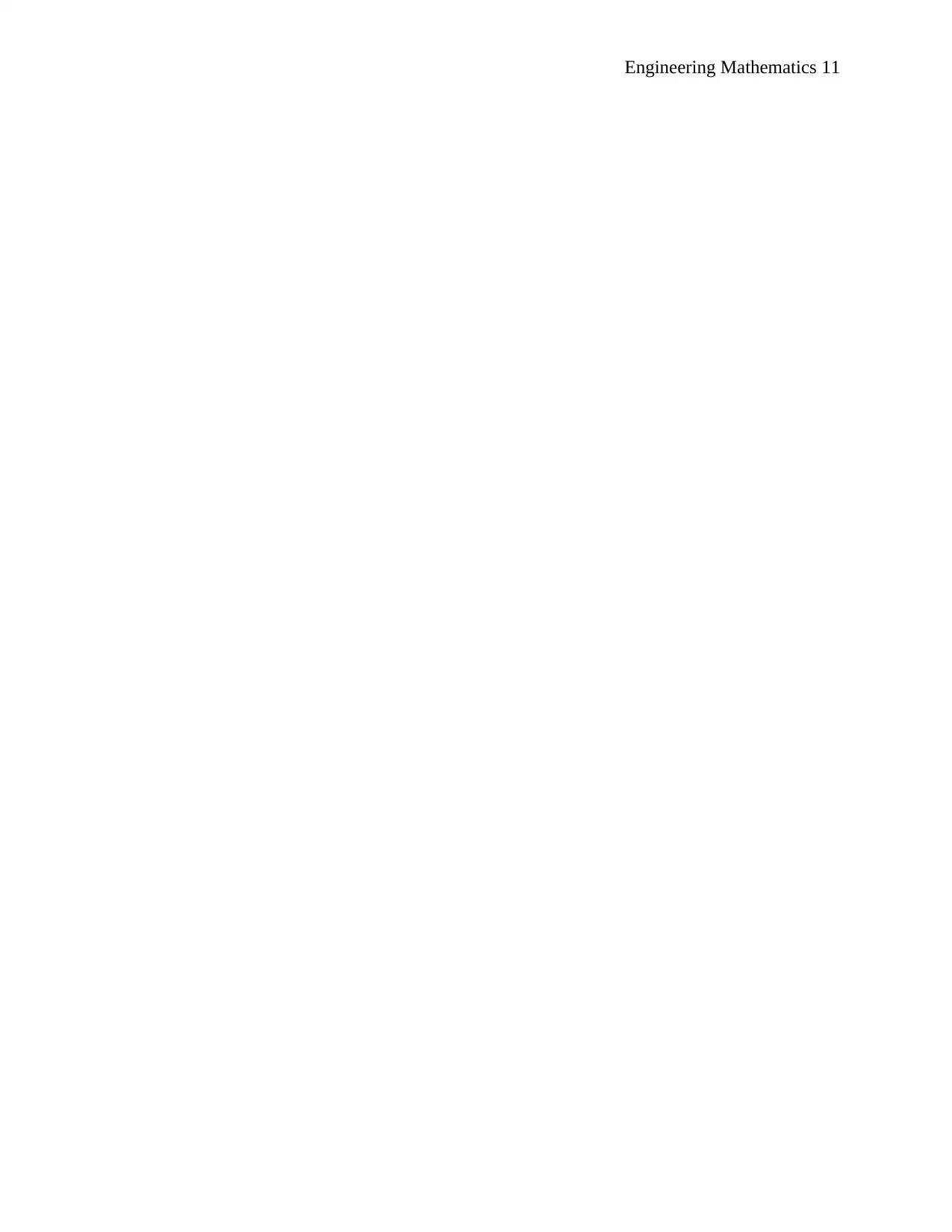
Engineering Mathematics 11
1 out of 11
Related Documents
Your All-in-One AI-Powered Toolkit for Academic Success.
+13062052269
info@desklib.com
Available 24*7 on WhatsApp / Email
![[object Object]](/_next/static/media/star-bottom.7253800d.svg)
Unlock your academic potential
© 2024 | Zucol Services PVT LTD | All rights reserved.





